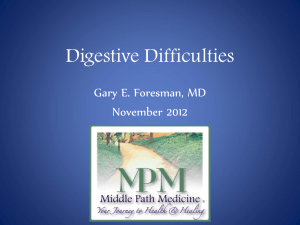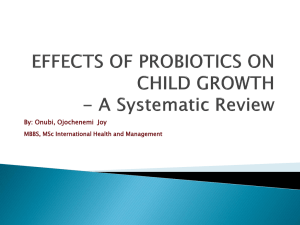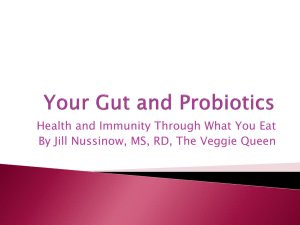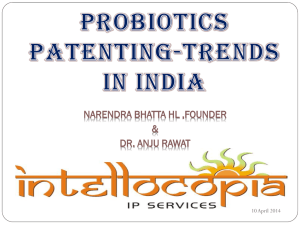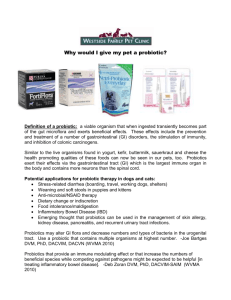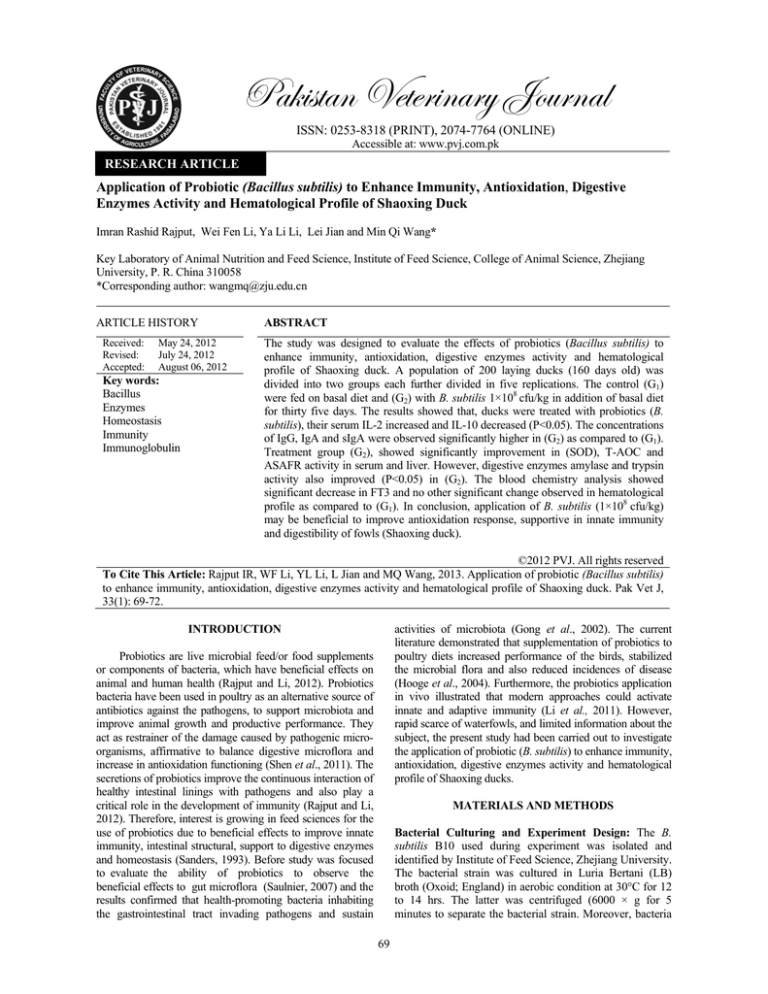
Pakistan Veterinary Journal
ISSN: 0253-8318 (PRINT), 2074-7764 (ONLINE)
Accessible at: www.pvj.com.pk
RESEARCH ARTICLE
Application of Probiotic (Bacillus subtilis) to Enhance Immunity, Antioxidation, Digestive
Enzymes Activity and Hematological Profile of Shaoxing Duck
Imran Rashid Rajput, Wei Fen Li, Ya Li Li, Lei Jian and Min Qi Wang*
Key Laboratory of Animal Nutrition and Feed Science, Institute of Feed Science, College of Animal Science, Zhejiang
University, P. R. China 310058
*Corresponding author: wangmq@zju.edu.cn
ARTICLE HISTORY
Received:
Revised:
Accepted:
May 24, 2012
July 24, 2012
August 06, 2012
Key words:
Bacillus
Enzymes
Homeostasis
Immunity
Immunoglobulin
ABSTRACT
The study was designed to evaluate the effects of probiotics (Bacillus subtilis) to
enhance immunity, antioxidation, digestive enzymes activity and hematological
profile of Shaoxing duck. A population of 200 laying ducks (160 days old) was
divided into two groups each further divided in five replications. The control (G1)
were fed on basal diet and (G2) with B. subtilis 1×108 cfu/kg in addition of basal diet
for thirty five days. The results showed that, ducks were treated with probiotics (B.
subtilis), their serum IL-2 increased and IL-10 decreased (P<0.05). The concentrations
of IgG, IgA and sIgA were observed significantly higher in (G2) as compared to (G1).
Treatment group (G2), showed significantly improvement in (SOD), T-AOC and
ASAFR activity in serum and liver. However, digestive enzymes amylase and trypsin
activity also improved (P<0.05) in (G2). The blood chemistry analysis showed
significant decrease in FT3 and no other significant change observed in hematological
profile as compared to (G1). In conclusion, application of B. subtilis (1×108 cfu/kg)
may be beneficial to improve antioxidation response, supportive in innate immunity
and digestibility of fowls (Shaoxing duck).
©2012 PVJ. All rights reserved
To Cite This Article: Rajput IR, WF Li, YL Li, L Jian and MQ Wang, 2013. Application of probiotic (Bacillus subtilis)
to enhance immunity, antioxidation, digestive enzymes activity and hematological profile of Shaoxing duck. Pak Vet J,
33(1): 69-72.
activities of microbiota (Gong et al., 2002). The current
literature demonstrated that supplementation of probiotics to
poultry diets increased performance of the birds, stabilized
the microbial flora and also reduced incidences of disease
(Hooge et al., 2004). Furthermore, the probiotics application
in vivo illustrated that modern approaches could activate
innate and adaptive immunity (Li et al., 2011). However,
rapid scarce of waterfowls, and limited information about the
subject, the present study had been carried out to investigate
the application of probiotic (B. subtilis) to enhance immunity,
antioxidation, digestive enzymes activity and hematological
profile of Shaoxing ducks.
INTRODUCTION
Probiotics are live microbial feed/or food supplements
or components of bacteria, which have beneficial effects on
animal and human health (Rajput and Li, 2012). Probiotics
bacteria have been used in poultry as an alternative source of
antibiotics against the pathogens, to support microbiota and
improve animal growth and productive performance. They
act as restrainer of the damage caused by pathogenic microorganisms, affirmative to balance digestive microflora and
increase in antioxidation functioning (Shen et al., 2011). The
secretions of probiotics improve the continuous interaction of
healthy intestinal linings with pathogens and also play a
critical role in the development of immunity (Rajput and Li,
2012). Therefore, interest is growing in feed sciences for the
use of probiotics due to beneficial effects to improve innate
immunity, intestinal structural, support to digestive enzymes
and homeostasis (Sanders, 1993). Before study was focused
to evaluate the ability of probiotics to observe the
beneficial effects to gut microflora (Saulnier, 2007) and the
results confirmed that health-promoting bacteria inhabiting
the gastrointestinal tract invading pathogens and sustain
MATERIALS AND METHODS
Bacterial Culturing and Experiment Design: The B.
subtilis B10 used during experiment was isolated and
identified by Institute of Feed Science, Zhejiang University.
The bacterial strain was cultured in Luria Bertani (LB)
broth (Oxoid; England) in aerobic condition at 30°C for 12
to 14 hrs. The latter was centrifuged (6000 × g for 5
minutes to separate the bacterial strain. Moreover, bacteria
69
70
were washed twice with Phosphate-Buffered Saline (PBS,
pH 7.3), and suspended in skim milk powder to prepare
required concentration (1×108 cfu/g). The prepared mixture
was added in to the feed (Table 1) and maintained (1×108
cfu/kg). A total of 200 shaoxing ducks, 160-days-old and at
laying, (average weigh 1.72±0.02kg) were randomly divided
into two groups, with five replications of each group having
20 ducks per replication. Control group (G1) was only fed on
basal diet (Table 1), while treatment group (G2) was fed on
basal diet with addition of B. subtilis (1 × 108 cfu/kg) for 35
days. Ducks were reared in standard farm conditions, spread
litter (wheat brown 3-4 inches thick), and free access of feed
and water along with facility of playground and fresh water
pond.
Table 1: Ingredients and nutrient levels of basal diet
Ingredients
(G/kg)
Nutrients
Content (g/kg)
Corn
465
CP
180
Soybean meal
230
Ca
30.9
Rapeseed Cake
80
P
7.5
Wheat flour
100
Lys
9.5
Mono calcium phosphate
15
Met
3.5
Limestone
67
Sodium Chloride
3
DE(MJ/kg)
11.4%
Premix compound1
10
Premix compound each kilogram contained: vitamin A, 5,000 IU;
cholecalciferol, 1,500 IU; tocopheryl acetate, 11 IU; menadione, 1.1 mg;
thiamine·HCl, 3.0 mg; riboflavin, 5.0 mg; pyridoxine·HCl, 2.2 mg;
cyanocobalamin, 0.66 meq; niacin, 44 mg; Ca pantothenate, 12 mg; choline
chloride, 220 mg; folic acid, 0.55 mg; D-biotin, 0.11 mg; Mn, 80.0 mg; Zn,
60.0 mg; Fe, 30.0 mg; Cu, 5.0 mg; I, 2.0 mg; and Se, 0.15 mg.
Blood, Digesta and liver sampling: After feeding trial of 35
days, ducks were scarified, as per recommendations of
Zhejiang University Animal Centre (ZUAC) and blood
samples were obtained from wing vein using 23 gauge
needles. Serum was separated and purified using
centrifugation (5,500 x g), for 10 minutes. Serum was
aspirated by pipette and transferred into 1.5 ml, sterilized
eppendorf tubes at -80°C for further analysis. The major
ramifications of digestive tract were collected, and the parts
were opened longitudinally with micro scalpel and
transferred into a separate sterilized tubes containing 10 M
PBS (7.4 pH) phosphate buffer saline and applied ultrasonic
treatment for 4 mints in order to separate the GUT contents
from the GIT tissue which were accomplished by
centrifugation (5000xg, 25mints at 4°C). After
centrifugation, supernatant was utilized to analyze enzymatic
activities. The liver was collected and sample (10 g) was
crushed with addition of normal saline (0.75%) with the ratio
of 1:4. Furthermore, sample was centrifuged (3000xg 30
mints, at 4°C) and supernatant was collected and freezed for
further analysis.
Determination of cytokines by ELISA: The ELISA test of
IL-2 IL-6 and IL-10, were performed as per manufacturer’s
(ELISA Kit; R&D Systems, Inc) instructions. In brief,
polyclonal goat anti-human IL-2, IL-6 and IL-10 antibodies
were applied as capturing antibodies, biotinylated polyclonal
rabbit anti-human IL-2, IL-6 and IL-10 antibodies as
detecting antibodies. Streptavidin- RP and TMBS were used
as color indicator. Well plates were read at (450 nm)
wavelength, right after color reaction was stopped with acid.
Metabolites and immunoglobulin (Ig): The nitric oxide
(NO), Free thyroxine (FT4), free triiodothyronine (FT3),
Pak Vet J, 2013, 33(1): 69-72.
corticosterone (CORT), creatine kinase (CK), lactate
dehydrogenase (LDH), total protein (TP), albumin (ALB),
globulin (GB), IgG, IgM, IgA, secretory IgA (sIgA).
Metabolites and immunoglobulins in serum were analyzed
using kits by following the instructions provided by
Jiancheng Bioengineering Institute (Nanjing, China).
Antioxidtive indicators measurement: The glutathione
peroxidase (GSH-Px), superoxide dismutase (SOD), total
antioxidation capacity (T-AOC), catalase (CAT), antisuperoxide anion free radical (ASAFR) and malondialdehyde (MDA), were determined in serum and liver. Briefly,
serum was obtained from blood by centrifugation at 5500 x g
for 10 mints. The liver supernatant was collected after, (10
grams) of tissue grinding with addition of NaCl (0.75%),
using super mixture machine. The centrifugation force 6000
x g for 15 mints was applied and supernatant collected for
further analysis. All the indicators were detected by the
instruction of manufacturers provided by (Jiancheng
Bioengineering Institute Nanjing, China).
Digestive enzymes assay: Amylase, lipase (LPS), trypsin
(TPS) and total protein hydrolase (TPH) were analyzed
following the instruction using kit, provided by Jiancheng
Bioengineering Institute (Nanjing, China). In brief, digesta
was transferred into sterilized tubes containing 10 M PBS
(7.4 pH) phosphate buffer saline, then ultrasonic treatment
was applied for 4 mints to dissociate the tissues. The letter
procedure was accomplished by centrifugation (5000 x g for
25 mints). The supernatant was used to determine the
enzymatic activates.
Statistical analysis: Data were analyzed using SPSS 16.0 for
Windows (SPSS Inc., Chicago, USA). The intergroup
variation was assessed by Paired-samples t test followed by
Fischer’s least significant difference (LSD) test. Statistical
significance of the results was calculated at P<0.05.
RESULTS
Serum cytokines and immunoglobulin: The probiotic
group showed, (P<0.05) lower concentration of antiinflammatory cytokine IL-10 (Fig.1) compared with control
group. While, the secretion of pro-inflammatory cytokine IL2 increased (P<0.05) in treatment group (G2), whereas no
significant difference was observed in production of IL-6
between treatment and control groups (G1).
The results showed, (Fig 2) that, significant increase
observed in IgG and IgA in probiotics addition group (G2) as
compared to control group (G1). However, there was no
significant difference observed in TP, ALB, GB, IgM and
sIgA concentration in between treatment (G2) and control
groups (G1).
Serum and liver antioxidant activities: Our findings
manifested (Table. 2), that significant improvement was
observed in SOD, T-AOC and ASAFR activities in treatment
group (G2), conversely MDA activity was increased (P
<0.05), in control group. While, no significant change was
observed in GSH-PX and CAT activities in between control
(G1) and treatment groups (G2).
Antioxidant activity of liver showed that SOD and TAOC significantly increased in treatment group (G2) as
71
compared to control group (G1) However, non-significant
change was observed in the GSH-PX, CAT, ASAFR
activities and MDA contents in between control (G1) and
treatment groups (G2).
Pak Vet J, 2013, 33(1): 69-72.
Table 3: Digestive enzymatic activity in Shaoxing duck
Contents
Control
Treatment
Amylase (µ/mg)
7.7±0.37
12.2±1.3*
Lipase (U/g)
296.8±14.7
313.5±21.1
Trypsin (U/mL)
1359.1±182.1
2204.5±153.8*
Total Protein Hydrolase (U/mL)
2.6±0.08
2.8±0.08
Values (Mean+SE) bearing asterisk in a row differ significantly (P<0.05).
Table 4: Metabolites level in shaoxing duck serum
Contents
Control
Treatment
Nitric oxide (µmol/L)
149.4±25.6
155.3±20.7
Free thyroxine (pg/mL)
250.9±15.3
266.01±9.04
FT3 free triiodothyronine (pg/mL)
885.8±24.6
740.1±27.5*
Corticosterone (ng/mL)
536.4±54.1
519.6±58.06
Creatine kinase (U/mL)
0.86±0.2
1.05±0.08
Lactate dehydrogenase (U/L)
2513.9±46.8
2809.3±198.4
Values (Mean+SE) bearing asterisk in a row differ significantly (P<0.05).
DISCUSSION
Fig. 1: The figure shows concentration of Interleukin-2, Interliukin-6 and
interleukin-10 in each group (mean±SE). Error bars represent standard
errors of the means of optical densities.*, statistically significant (P<0.05).
Fig. 2: The figure shows secretion (mean±SE) proteins
immunoglobulins. *,Indicates statistically (P<0.05) difference.
and
Digestive enzyme activity analysis: Specific enzymes
activity (Table 2) among the digestive enzymes of
Shaoxing duck, LPS, TPH, and LE activity showed no
variation between experimental groups with probiotic
supplement (G2) and control group (G1) without probiotics
addition. Treatment group had high levels of AMS
(P<0.05) while, TPS enzyme showed remarkable decrease
(P<0.05) in G2 compared with control group (G1).
Metabolites of serum:
Serum metabolites changes
showed (Table 4) that treatment group (G2) significantly
decreased free triiodothyronine FT3 (P<0.05) as compared
to (G1) control group. Whilst, there was no significant
difference manifested in nitric oxide (NO), free thyroxine
(FT4), corticosterone (CORT), creatine kinase (CK) and
lactate dehydrogenase (LDH) concentration between
treatment (G2) and control groups (G1).
Table 2: Antioxidant levels (mean±SE) in Shaoxing duck serum and liver
Serum
Liver
Units
Control
B. subtilis
Control
B. subtilis
GSH-PX U/ mgprot 353.5±61.9 345.1±43.4 281.5±62.7 368.5±75.4
SOD
U/ mgprot 106.7±5
130.4±7.8* 123.7±10.2 141.9±6.4
T-AOC U/ mgprot
9.7±1.1
19.2±3.1* 328.9±32.8 520.4±70.7*
CAT
U/ mgprot
12.9±3.1
24±2.8
40.5±8.4 62.5±7.4
ASAFR U/ mgprot 137.5±33.3 250.6±29.2* 443.3±16.6 438.6±18
MDA
nmol/mgprot 1.41±0.19 0.76±0.13* 3.80±0.33 2.53±0.44
*Indicates statistically (P<0.05) difference in a row.
Contents
Although, the functions of probiotics to enhance
immunity and their responses against pathogens have been
well demonstrated in mammals, but poorly implicit in fowls.
However, the recent studies are in progress to establish the
information about avian immune response to probiotics. IL-2
is an inflammatory cytokine which plays an important role to
endorse cell mediated immunity related to Th1 cells (Rajput
and Li, 2012). IL-6 cytokine has pro-inflammatory activity
via the induction of acute phase protein synthesis, and is
important in the development of adaptive immune responses
(Hirana, 1994). IL-10 inhibits the synthesis of proinflammatory cytokines, thus down-regulating inflammatory
Th1 responses (Groux and Powrie, 1999).
Our current findings suggested that probiotics
(Bacillus subtilis) can support to enhance the production of
inflammatory cytokine IL-2 and decrease the amount of IL10 and no significant change was observed in serum IL-6
level. The supportive findings of (Huang et al., 2012)
described that concentrations of pro-inflammatory
cytokines increased and response varies depends on
probiotic species. While in contrast (Hong et al., 2006)
found that, S. enteritidis as an infection has little effect on
IL-2 cytokine production and down-regulates IL-2 mRNA
expression. Another study (Weinstein et al., 1998) reported
that, invasion of S. typhi into human or murine epithelial
cells resulted in the production of high levels of IL-6. Our
finding revealed that, application of Bacillus subtilis B10
may have in favor of application to develop immunity,
antioxidation response and digestive enzyme improvement.
Probiotics enhance the systemic antibody response to
soluble antigens, in serum and participate in the
development of immunity (Christensen et al., 2002). In one
study, ducks supplemented with B. subtilis showed
enhanced and IgG IgA and sIgA response (Koenen et al.,
2004). In another study, the administration of probiotics
containing Lactobacillus acidophilus and Lactobacillus
casei enhanced the serum IgA and IgG response, while the
treatment did not influence other immunoglobulins (Huang
et al., 2004). Our results are in agreement of previous
studies, and found significant increase in IgG and IgA in
probiotic addition group as compared to (G1) control group.
The possibility of the effects by probiotics, is stimulation of
immune cells subsequently cytokine production (Lammers
et al., 2003) and in possible cytokines IL-4 and IL-10, have
important functions and modulate immune response
72
(Rakoff et al., 2004). Our results revealed application of
probiotics stimulate immunity development in waterfowls.
The important components of the antioxidative
enzymes including GSH-Px, SOD, T-AOC, CAT and
ASAFR, play a vital function for self defense (Miller and
Britigan, 1997). Our results indicated that, T-AOC
activities significantly increased in (G2) as compared to
(G1). These findings are in agreement with the previous
observations of (Capcarova et al., 2010). Enterococcus
faecium also has oxidation resistance, scavenges hydroxyl
radical and increases antioxidant capacity (Wen et al.,
2011). With regard to antioxidant activity, L. acidophilus
supernatant showed DPPH radical scavenging activity (Lee
et al., 2008). Our results demonstrate the potential use of
probiotics B. subtilis is health-promotion.
The amylase, lipase, trypsin and total protein hydrolase
play an important role in the, digestion, and/or fermentation
of relative nutrient materials with ultimate improvement in
animal performance and health. The results of present study
demonstrated that amylase and trypsin activity was
significantly higher in G2 but lipase and TPH was not
affected when compared with G1 after 35 days of feeding.
Current results were similar to the finding of Jin et al.
(2000), who reported that inclusion of a probiotics (a single
strain of L. acidophilus or a mixture of 12 Lactobacillus
strains) resulted in significantly higher enzyme activities in
the small intestine of broilers.
Bacteria, particularly members of the genus Bacillus
secrete a wide range of exoenzymes (Pugsley and
Schwartz, 1985). We could not distinguish between activity
due to enzymes synthesized by the fowl and due to
enzymes synthesized by the probiotics. However, the
exogenous enzymes produced by the probiotics represents,
only a small contribution to the total enzyme activity of the
intestine (Bedford and Schulze, 1998). The application of
probiotics might stimulate the production of endogenous
enzymes which contribute to develop harmonious
environment of intestine for better digestion in fowls.
The brids treated with probiotics in addition to basal
diet (G2) serum chemistry profile showed no significant
effects, except the free triiodothyronine (FT3) statistically
decreased than control group. There is positive correlation
in between adhesion of probiotic bacteria to epithelium and
decrease in FT3. Our findings proved probiotic B. subtilis is
a beneficial bacteria to overall development of immunity
of birds, and several studies in agreement that, different
probiotics have immune-stimulatory, anti-inflammatory and
antiviral effects (Klocking et al., 2002; Joone et al., 2003;
Joone and van Rensburg, 2004).
In conclusion, the current study manifested several
prospective effects of probiotic (B. subtilis) B10 could
induce innate immunity, enhanced antioxidation and
improved digestibility via digestive enzymes and beneficial
modulation in hematological profile, of waterfowl
(Shaoxing) duck.
REFERENCES
Bedford MR and H Schulze, 1998. Exogenous enzymes for pigs and poultry.
Nutr Res Rev, 11: 91-114.
Capcarova M, J Weiss, C Hrncar, A Kolesarova and G Pal, 2010. Effect of
Lactobacillus fermentum and Enterococcus faecium strains on internal
milieu, antioxidant status and body weight of broiler chickens. J Anim
Physiol Anim Nutr, 94: 215-224.
Pak Vet J, 2013, 33(1): 69-72.
Christensen HR, H Frokiaer and JJ Pestka, 2002. Lactobacilli differentially
modulate expression of cytokines and maturation surface markers in
murine dendritic cells. J Immunol, 168: 171-178.
Gong J, RJ Forster, H YU, JR Chambers, R Wheat Craft, PM Sabour and
C Shu, 2002. Molecular analysis of bacterial populations in the
ileum of broiler chickens and comparison with bacteria in the
cecum. FEMS Microbiol Ecol, 41: 171-179.
Groux H and F Powrie, 1999. Regulatory T cells and inflammatory bowel
disease. Immunology, 20: 442- 445.
Hinton JR, RJ Buhr and KD Ingram, 2000. Reduction of salmonella in the
crop of broiler chickens subjected to feed withdrawal. Poult Sci, 79:
1566-1570.
Hirana T, 1994. Interleukin 6 and its receptor: 10 years later. Inter Rev
Immunol. 16: 249-284.
Hong YH, HS Lillehoj, RA Dalloul, W Min, KB Miska, W Tuo, SH Lee, JY
Han and EP Lillehoj, 2006. Molecular cloning and characterization of
chicken NK-lysin. Vet Immunol Immunopathol, 110: 339-347.
Hooge DM, H Ishimaru, and MD Sims, 2004. Influence of dietary Bacillus
subtilis C-3102 spores on live performance of broiler chickens in four
controlled pen trials. The J Appl Poul Res, 13: 222-228.
Huang MK, YJ Choi, R Houde, JW Lee, B Lee and X Zhao, 2004. Effects of
Lactobacilli and an acidophilic fungus on the production performance
and immune responses in broiler chickens. Poult Sci, 83: 788-795.
Jin LZ, YW Ho, N Abdullah and S Jalaludin, 2000. Digestive and bacterial
enzyme activities in broilers fed diets supplemented with Lactobacillus
cultures. Poult Sci, 79: 886-891.
Joone GK and CE Van Rensburg, 2004. An in vitro investigation of the antiinflammatory properties of potassium humate. Inflammation, 28: 169174.
Joone GK, J Dekker and CE Van Rensburg, 2003. Investigation of the
immunostimulatory properties of oxihumate. Zeitschrift fur
Naturforschung, 58: 263-267.
Klocking R, B Helbig, G Schotz, M schacke and P Wutzler, 2002. Anti-HSV-1
activity of synthetic humic acid-like polymers derived from pdiphenolic
starting compounds. Antivir Chem Chemoth, 13: 241-249.
Koenen ME, J Kramer, R Van Der Hulst, L Heres, SHM Jeurissen and WJA
Boersma, 2004. Immunomodulation by probiotic lactobacilli in layerand meat-type chickens. Br Poult Sci, 45: 355-366.
Lammers KM, P Brigidi, B Vitali, P Gionchetti, F Rizzello, E Cara-Melli, D
Matteuzzi and M Campieri, 2003. Immunomodulatory effects of
probiotic bacteria DNA: IL-1 and IL-10 response in human peripheral
blood mononuclear cells. FEMS Immunol Med Microbiol, 38: 165-172.
Lee NK, CW Yun, SW Kim, HI Chang, CW Kang and HD Paik, 2008.
Screening of Lactobacilli Derived from Chicken Feces and Partial
Characterization of actobacillus acidophilus A12 as animal probiotics. J
Microbiol Biotechnol, 18: 338-342.
Li WF, W Jing, WH Zhao, Z Ling and YD You, 2011. Effects of Bacillus subtilis
on growth performance, antioxidant capacity and immunity of
intestinal mucosa in broilers. Chinese J Anim Sci, 47: 58-61.
Miller RA and BE Britigan, 1997. Role of oxidants in microbial
pathophysiology. Clin Microbiol Rev, 10: 1-18.
Pugsley AP and M Schwartz, 1985. Export and secretion of proteins by
bacteria. FEMS Res Rev, 11: 91-114.
Rajput IR and WF LI, 2012. Potential role of probiotics in mechanism of
intestinal immunity. Pak Vet J, 32: 303-308.
Rakoff NS, J Paglino, F Eslami-Varzaneh, S Edberg and R Medzhitov, 2004.
Recognition of commensal microflora by toll-like receptors is required
for intestinal homeostasis. Cell, 118: 229-241.
Sanders ME 1993. Summary of conclusions from a panel of experts on health
attributes of lactic cultures: Significance to fluid milk products
containing cultures. J Dairy Sci, 76: 1819-1828.
Saulnier DM, 2007. Identification of prebiotic fructooligosaccharide
metabolism in Lactobacillus plantarum WCFS1 through microarrays.
Appl Environ Microbiol, 73: 1753.
Shen, WY, WF LI, Q Liang, B Deng, NN Chen and XX Zhou, 2011. Effects
of dietary Bacillus subtilis on growth performance immunity and
antioxidant function of grass carp (Ctenopharyngodon idellus). Chinese
J Anim Nutr, 23: 881-886.
Weinstein KC, C Sick, B Kaspers and P Staeheli, 1998. A chicken homologue
of mammalian interleukin-1b: cDNA cloning and purification of active
recombinant protein. Euro J Biochem, 258: 994-1000.
Wen J, JA Sun, XX Zhou and WF Li, 2011. Effects of Enterococcus faecium on
growth performance, immune and antioxidant function of piglets. Acta
Agric Zhejiang (China), 23: 70-73.
Huang Y, YL Li, Q Huang, ZW Cui, DY Yu, IR Rajput, CH Hu and WF
Li, 2012. Effect of orally administered Enterococcus faecium EF1 on
intestinal cytokines and chemokines production of suckling piglets.
Pak Vet J, 32: 81-84.

